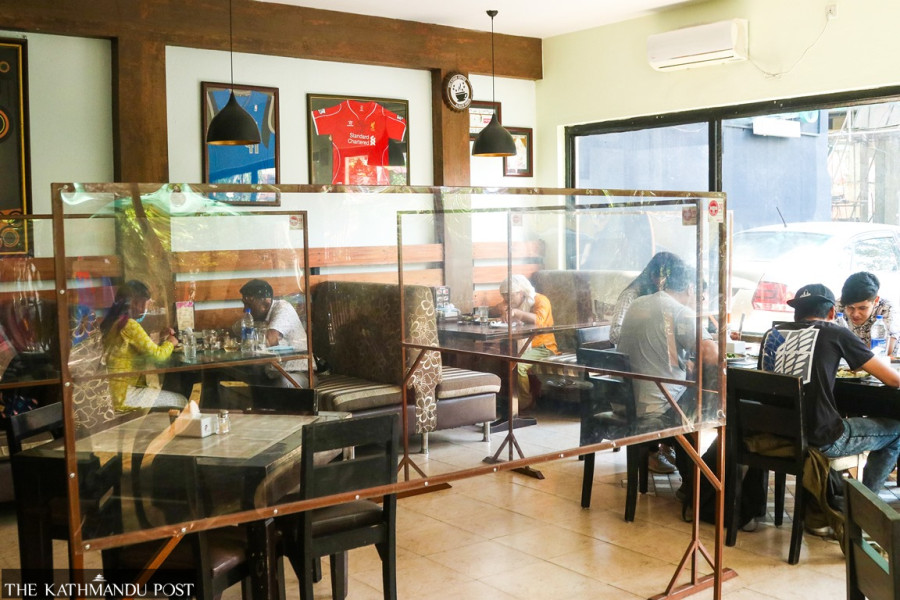Culture & Lifestyle
How dining out has changed since Covid-19
Health, safety, and sanitation are on the top of diners’ minds amidst the pandemic, and restaurateurs seem to have taken note.
Aakriti Ghimire
For twenty-year-old Deevna Karki, going out to eat has always been one of her favourite things to do, and food and ambience were the two most important factors when choosing restaurants to visit. But ever since the pandemic hit the country last year, Karki shares that her priorities in selecting a restaurant have shifted considerably.
“Nowadays, apart from food and ambience, space is another important factor. If a restaurant is small, it will most likely be crowded, increasing the risk of transmission of Covid-19. Another equally important aspect is proper hygiene, and sanitary protocols, which I think are a must-have in every restaurant," says Karki.
Early last year, when Nepal went into its first nationwide lockdown to curb the spread of Covid-19, restaurants across the country were forced to shut. When the lockdowns loosened by the end of the year, many restaurants, unable to bear the losses, had shut down. Restaurants that were able to survive now find themselves navigating a much-changed dining out landscape; one where sanitation, health, and safety protocols are key to gain diners’ confidence.
Karki, who is a final-year marketing student at Kathmandu College of Management, is not alone in shifting her priorities while choosing a restaurant to dine in.
Aleesah Sapkota, a food vlogger who runs the Instagram handle @Foodnommics, visits around seven restaurants on a weekly basis for reviews. Since last year, before going to review restaurants, she has been considering the spaciousness of the restaurants she visits. In addition to that, she also looks at sanitary protocols implemented in the restaurant. “Sanitation is a priority. I look for places where temperatures are checked, sanitisers are placed on every table, tables are sanitised after each customer leaves, and whether the waiters are wearing masks or not,” she says.
The strong emphasis diners have been placing on health, hygiene, and safety protocols have not gone unnoticed by restaurants. Many of these businesses have also made changes to their operations to cater to customers’ needs.
Tucked away in the lush Gokarna forest, Gokarna Forest Resort is one of the Valley’s premium hotels and operates several restaurants within its premises.
According to Rojin Sapkota, the resort’s director of room division, all the staff at Gokarna Forest Resort are vaccinated, and everyone–the staff and customers–undergoes a mandatory screening process before entering the restaurants. Stickers that require people to maintain a two metres physical distance are stuck in the premises. Sanitisers are available everywhere, and masks are mandated for the staff and customers. Doors, handles, and latches are sanitised every three hours by the staff.
“We have implemented all the protocols required by the Nepal Government and the World Health Organisation (WHO),” shares Rojin.
At Jimbu Thakali, a restaurant chain famous for its Thakali cuisine, plastic barriers between tables have been placed as a safety precaution. “In the beginning, we collected contact details of our customers and had implemented policies of contact tracing as well. We have relaxed a little on that front, as the Covid situation has become better,” according to Vivek Sherchan, the owner of Jimbu Thakali.
Some restaurants have gone a step further to ensure safety. According to Sajita Pradhan, partner and managing director at Tamarind chain of restaurants (which operate Embassy Restaurant, Tamarind, Zen Bistro, Oskar, Tamarind Khaja Ghar, and Somewhere in Kathmandu), antigen test kits have been placed at all of their restaurants for their staff. “In case any of our staff shows any Covid-19-related symptoms, we immediately get their tests done at the restaurant itself,” says Pradhan.
But these sanitation and safety protocols have increased operational costs for businesses. Adding further to the cost is the increase in the prices of food ingredients. But in an economically volatile environment, many restaurants are refraining from increasing menu prices. To cut costs, many have resorted to downsizing their staff.
“Installing safety protocols within all our restaurant chains is expensive, but we include those in our operational costs. We can’t reflect those costs on our food because if we raise our prices today, we will not be able to sustain ourselves in this uncertain period. We want to be able to ride through this phase for now,” shares Pradhan. “We are now operating with around 30 percent less staff.”
According to Rojin, Gokarna Forest Resort is operating with only 35 to 40 percent of its regular staff.
“We have had to implement a lot of safety protocols ever since the pandemic, but we have kept our prices the same as they were before the pandemic. Since everyone’s income has been affected by the pandemic, the market is very sensitive,” says Rojin. “We cannot run after profit at this time. The sole purpose, for now, is survival.”
By keeping prices the same, many restaurants focus more on volume than higher profit margins.
The restaurants the Post spoke to say that another major shift that they have observed are in their customer demographics. Before the pandemic, restaurants that catered primarily to families are now seeing an influx of young customers.
“Post the second lockdown, we have been receiving a huge influx of young diners,” says Sherchan. “Perhaps, it is the confidence that the youth have or the fact that they have overcome the fear factor of the pandemic.”
Sherchan hypothesises that this growth is because Thamel’s nightlife is yet to revive to its pre-pandemic level.
“Many of Thamel’s bars, pubs, and clubs are yet to open, so naturally youngsters are seeking other options where they can eat and spend time until late,” says Sherchan.
Karki agrees with Sherchan that the closure of many of Thamel’s popular businesses has caused many youngsters her age to explore other locations to dine.
“Before the pandemic, my friends and I used to hang out mostly in Jhamsikhel and Thamel, but since last year we have started branching out to Baluwatar, Maharajgunj, Bouddha, and even Nagarkot,” says Karki.
The surge in youngsters dining out after last year’s protracted lockdown, says Rachana Thapa, director of academics at Silver Mountain School of Hotel Management, is not an anomaly.
“Historically, after both the world wars, people started going out and spending extravagantly on things and activities they couldn’t do during the wars,” says Thapa. “That is exactly what’s happening in this pandemic-war-like situation. Youngsters are going out a lot because they were deprived of it during the months-long lockdowns. And social media has also made eating out a trendy thing to do these days.”
Thapa thinks the trend of older adults preferring to skip dining out is because many have contracted Covid or have seen people of their age get infected.
“I think people my age prefer to order food or cook at home because of safety concerns,” says Thapa.
While restaurant businesses have suffered due to the pandemic, the surge in Nepalis travelling and dining out has industry stakeholders optimistic.
“The growth in domestic tourism is an excellent opportunity for the Nepali economy. Albeit the crowd is only on weekends for us, it is essential to sustain this growth. The government has to focus on providing better infrastructures for easy accessibility of domestic tourists. If done right, we can be sustainable in the domestic market,” says Rojin.
Despite the many challenges brought forward by the pandemic, some restaurateurs have even opened new restaurants amidst the pandemic. Pradhan launched Somewhere in Kathmandu, a restaurant in Naxal, about a month ago and Sherchan launched a new outlet of Jimbu Thakali in Baneshwor, two months ago. Both say they are surprised and happy with the footfall.
However, hospitality experts are concerned that the pandemic-induced hygiene protocols are not here to remain for long.
Khem Lakai, Founder of GATE (Global Academy of Tourism and Hospitality Education) College, explains that these protocols should have been in place before the pandemic. “Sanitisers and paper towels should have been a mandatory policy before licensing restaurateurs themselves. Proper food handling, sanitising food items with potash water or saltwater, being conscious about cross-contamination are very crucial to healthy eating.”
Thapa echoes Lakai’s concerns. She adds that while vaccines have provided a sense of security, the restaurateurs have a sense of responsibility concerning sanitation. “Restaurants should make masks mandatory, and workplace attire of servers at the restaurants must be sanitised. Having said that, if a restaurant is to sustain itself in the long-term, it should not compromise on its food quality,” she says.
Lakai, a WASH expert in the hospitality sector, is concerned that the industry might lose this window of opportunity to implement sustainable change. He shares, “Restaurants are waiting for the normal to be back so that they can operate in a pre-pandemic manner. We are missing this opportune moment to level up our hospitality sector on par with international standards.”
The recent decrease in the number of daily Covid-19 positive cases and surge in vaccination has already caused the public to become lax in taking safety precautions, and the same is reflected in many restaurants.
“Many restaurants have already stopped taking the temperatures of diners or providing sanitisers at the tables,” says food vlogger Aleesah, whose Instagram page has more than 72,000 followers. “Many waiters nowadays aren’t even wearing masks, which is very concerning.”




 17.12°C Kathmandu
17.12°C Kathmandu













%20(1).jpg&w=300&height=200)

